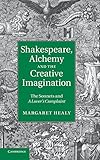Shakespeare, alchemy and the creative imagination: the sonnets and a lover`s complaint
Material type: TextPublication details: New Delhi Cambridge University Press 2011Description: 260pISBN: 9781107004047Subject(s): Shakespeare-Criticism | Shakespeare`s sonnets | English dramaDDC classification: 821.3 Summary: Shakespeare's Sonnets and A Lover's Complaint constitute a rich tapestry of rhetorical play about Renaissance love in all its guises. A significant strand of this is spiritual alchemy: working the 'metal' of the mind through meditation on love, memory work and intense imagination. Healy demonstrates how this process of anguished soul work - construed as essential to inspired poetic making - is woven into these poems, accounting for their most enigmatic imagery and urgency of tone. The esoteric philosophy of late Renaissance Neoplatonic alchemy, which embraced bawdy sexual symbolism and was highly fashionable in European intellectual circles, facilitated Shakespeare's inscription of an interior drama of a desiring mind creating poetry. Arguing that Shakespeare's incorporation of alchemical textures throughout his late works is indicative of an artistic stance promoting religious toleration and unity, this book sets out a crucial new framework for interpreting the 1609 poems, and transforms our understanding of Shakespeare's art.
TextPublication details: New Delhi Cambridge University Press 2011Description: 260pISBN: 9781107004047Subject(s): Shakespeare-Criticism | Shakespeare`s sonnets | English dramaDDC classification: 821.3 Summary: Shakespeare's Sonnets and A Lover's Complaint constitute a rich tapestry of rhetorical play about Renaissance love in all its guises. A significant strand of this is spiritual alchemy: working the 'metal' of the mind through meditation on love, memory work and intense imagination. Healy demonstrates how this process of anguished soul work - construed as essential to inspired poetic making - is woven into these poems, accounting for their most enigmatic imagery and urgency of tone. The esoteric philosophy of late Renaissance Neoplatonic alchemy, which embraced bawdy sexual symbolism and was highly fashionable in European intellectual circles, facilitated Shakespeare's inscription of an interior drama of a desiring mind creating poetry. Arguing that Shakespeare's incorporation of alchemical textures throughout his late works is indicative of an artistic stance promoting religious toleration and unity, this book sets out a crucial new framework for interpreting the 1609 poems, and transforms our understanding of Shakespeare's art.
| Item type | Current library | Call number | Status | Date due | Barcode |
|---|---|---|---|---|---|
 BK
BK
|
Stack | 821.3 HEA/S (Browse shelf (Opens below)) | Available | 29274 |
Browsing Kannur University Central Library shelves, Shelving location: Stack Close shelf browser (Hides shelf browser)

|

|

|

|

|

|

|
||
| 821.109 CHA Chaucer: the Canterbury tales: a casebook | 821.109 CHA Chaucer's cultural geography | 821.109 SHI/F Fourteen gems of English poetry | 821.3 HEA/S Shakespeare, alchemy and the creative imagination: the sonnets and a lover`s complaint | 821.3 SHA Shakespeare, the sonnets: a casebook | 821.3 SHA/S The sonnets | 821.308 NEW The new Oxford book of sixteenth century verse |
Shakespeare's Sonnets and A Lover's Complaint constitute a rich tapestry of rhetorical play about Renaissance love in all its guises. A significant strand of this is spiritual alchemy: working the 'metal' of the mind through meditation on love, memory work and intense imagination. Healy demonstrates how this process of anguished soul work - construed as essential to inspired poetic making - is woven into these poems, accounting for their most enigmatic imagery and urgency of tone. The esoteric philosophy of late Renaissance Neoplatonic alchemy, which embraced bawdy sexual symbolism and was highly fashionable in European intellectual circles, facilitated Shakespeare's inscription of an interior drama of a desiring mind creating poetry. Arguing that Shakespeare's incorporation of alchemical textures throughout his late works is indicative of an artistic stance promoting religious toleration and unity, this book sets out a crucial new framework for interpreting the 1609 poems, and transforms our understanding of Shakespeare's art.


There are no comments on this title.